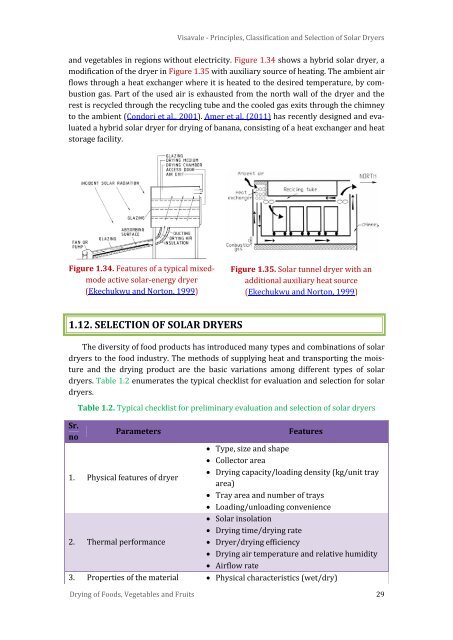Solar Drying: Fundamentals,Applications and Innovations - National ...
Solar Drying: Fundamentals,Applications and Innovations - National ...
Solar Drying: Fundamentals,Applications and Innovations - National ...
You also want an ePaper? Increase the reach of your titles
YUMPU automatically turns print PDFs into web optimized ePapers that Google loves.
Visavale - Principles, Classification <strong>and</strong> Selection of <strong>Solar</strong> Dryers<br />
<strong>and</strong> vegetables in regions without electricity. Figure 1.34 shows a hybrid solar dryer, a<br />
modification of the dryer in Figure 1.35 with auxiliary source of heating. The ambient air<br />
flows through a heat exchanger where it is heated to the desired temperature, by combustion<br />
gas. Part of the used air is exhausted from the north wall of the dryer <strong>and</strong> the<br />
rest is recycled through the recycling tube <strong>and</strong> the cooled gas exits through the chimney<br />
to the ambient (Condori et al., 2001). Amer et al. (2011) has recently designed <strong>and</strong> evaluated<br />
a hybrid solar dryer for drying of banana, consisting of a heat exchanger <strong>and</strong> heat<br />
storage facility.<br />
Figure 1.34. Features of a typical mixedmode<br />
active solar-energy dryer<br />
(Ekechukwu <strong>and</strong> Norton, 1999)<br />
Figure 1.35. <strong>Solar</strong> tunnel dryer with an<br />
additional auxiliary heat source<br />
(Ekechukwu <strong>and</strong> Norton, 1999)<br />
1.12. SELECTION OF SOLAR DRYERS<br />
The diversity of food products has introduced many types <strong>and</strong> combinations of solar<br />
dryers to the food industry. The methods of supplying heat <strong>and</strong> transporting the moisture<br />
<strong>and</strong> the drying product are the basic variations among different types of solar<br />
dryers. Table 1.2 enumerates the typical checklist for evaluation <strong>and</strong> selection for solar<br />
dryers.<br />
Table 1.2. Typical checklist for preliminary evaluation <strong>and</strong> selection of solar dryers<br />
Sr.<br />
no<br />
Parameters<br />
Features<br />
1. Physical features of dryer<br />
• Type, size <strong>and</strong> shape<br />
• Collector area<br />
• <strong>Drying</strong> capacity/loading density (kg/unit tray<br />
area)<br />
• Tray area <strong>and</strong> number of trays<br />
• Loading/unloading convenience<br />
2. Thermal performance<br />
• <strong>Solar</strong> insolation<br />
• <strong>Drying</strong> time/drying rate<br />
• Dryer/drying efficiency<br />
• <strong>Drying</strong> air temperature <strong>and</strong> relative humidity<br />
• Airflow rate<br />
3. Properties of the material • Physical characteristics (wet/dry)<br />
<strong>Drying</strong> of Foods, Vegetables <strong>and</strong> Fruits 29

















